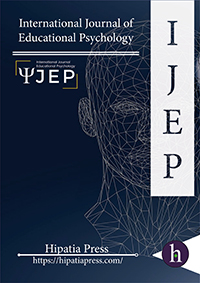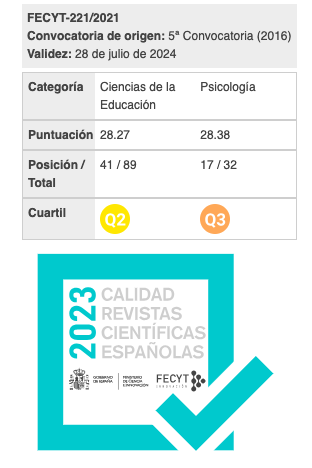Enhancing Historical Reasoning: A Strategy Including Formative Assessment with Systematic Continuous Feedback
Keywords:
Downloads
Abstract
Learning History promotes students’ reasoning. According to Van Drie & Van Boxtel (2008), historical reasoning involves six elements: substantive concepts, metaconcepts, asking historical questions, using sources, contextualization, and argumentation. Although there are didactic strategies that promote historical reasoning, these do not include systematic continuous feedback using rubrics, which can be useful both in assessing and promoting students’ progress and progression of ideas on metaconcepts. This study described the development of the six historical reasoning elements in a strategy that included formative assessment for K8 students. A case study was carried out in Mexico City: four teams of three students were formed according to their knowledge of history, with a single History teacher providing continuous systematic feedback on metaconcepts by using graded rubrics. Results showed that the six historical reasoning elements were developed in different ways and suggested possible methods for use in future didactics.
Downloads
References
Abad, F., Olea J., Ponsoda, V., y García, C. (2011), Medición en ciencias sociales y de la salud, España: Síntesis.
Google Scholar CrossrefAndrade, H., & Du, Y. (2005). Student perspectives on rubric-referenced assessment”. Practical Assessment, Research & Evaluation, 10 (3), 1-11.
Google Scholar CrossrefAPA (2010). Ethical Principles of Pyschologists and Code of Conduct http://www.apa.org/ethics/code/principles.pdf (Accessed 2013-03-14).
Google Scholar CrossrefAusubel, D. P., Novak, J. D., & Hanesian, H. (1968). Educational psychology: A cognitive view.
Google Scholar CrossrefBlack, P., & Wiliam, D. (2009). Developing the theory of formative assessment. Educational Assessment, Evaluation and Accountability (formerly: Journal of Personnel Evaluation in Education), 21(1), 5-31.
Google Scholar CrossrefCarretero, M., & Castorina, J. (2010). La construcción del conocimiento histórico. Enseñanza, narración e identidades. Argentina: Paidós.
Google Scholar CrossrefCarretero, M., Jacott, L., & López-Manjón, A. (2002). Learning history through textbooks: are Mexican and Spanish students taught the same story?. Learning and Instruction, 12 (6), 651-665.
Google Scholar CrossrefCarretero, M., & Montanero, M. (2008). Enseñanza y aprendizaje de la Historia: aspectos cognitivos y culturales. Cultura y Educación, 20 (2), 133-142.
Google Scholar CrossrefChesnaux, J. (2009). ¿Hacemos tabla rasa del pasado? México, DF: Siglo XXI.
Google Scholar CrossrefCoffin, C., & O’Halloran, K. A. (2009). Argument reconceived?. Educational Review, 61(3), 301-313.
Google Scholar CrossrefCounsell, C. (2000). 5 Historical knowledge and historical skills. Issues in history teaching, 54-71.
Google Scholar CrossrefDankert, S. (2006). Patters in Student’s Argumentation Confronted with a Risk-focused Socio-scientific Issue. International Journal of Science Education, 28 (14), 1689-1716.
Google Scholar CrossrefDickinson, A.K., & Lee, P.J. (1980). History Teaching and Historical Understanding. Heinemann: London, 1-19.
Google Scholar CrossrefDuschl, R. A., Schweingruber, H. A., & Shouse, A. E. (Eds.). (2007). Taking science toschool: Learning and teaching science in grades K-8. Washington, DC: National Academies Press.
Google Scholar CrossrefErduran, S., Simon, S., & Osborne, J. (2004). TAPping into argumentation: Developments in the application of Toulmin's argument pattern for studying science discourse. Science education, 88(6), 915-933.
Google Scholar CrossrefHalldén, O. (1997). Conceptual change and the learning of history. International Journal of Educational Research, 27, 201-210.
Google Scholar CrossrefHalldén, O. (1998). Personalization in historical descriptions and explanations. Learning and Instruction, 8 (2), 131-139.
Google Scholar CrossrefHeritage, M. (2010). Formative Assessment and next-generation Assessment Systems: Are We Losing an Opportunity?. Council of Chief State School Officers, 1-20.
Google Scholar CrossrefHicks, D., Doolittle, P., & Lee, J. (2004). Social Studies’ Teachers Use of Classroom Based and Web-Based Historical Primary Sources. Theory and Research in Social Education. 32, (2), 213-247.
Google Scholar CrossrefKelly, G. J., & Chen, C. (1999). The sound of music: Constructing science as sociocultural practices through oral and written discourse. Journal of Research in Science Teaching, 36(8), 883-915.
Google Scholar CrossrefKuhn, D. (1991). The skills of argument. Cambridge University Press.
Google Scholar CrossrefLave, J., & Wenger, E. (1991). Situated learning, legitimate peripheral participation. New York: Cambridge University Press.
Google Scholar CrossrefLee, J.K. (2002). Digital history in the history/social studies classroom. History Teacher, 503-517.
Google Scholar CrossrefLee, P. & Shemilt, D. (2003). A scaffold, not a cage: progression and progression models in history. Teaching History, 113, 13-22.
Google Scholar CrossrefLe Goff, J. (2005). Pensar la historia. Modernidad, presente, progreso. Mexico: Paidós.
Google Scholar CrossrefLévesque, S. (2008), Thinking Historically. Educating Students for the Twenty-First Century. Canada: University of Toronto.
Google Scholar CrossrefLévesque, S. (2008a). 2. The impact of digital technologies and the need for technological pedagogical content knowledge. The Emperor’s New Computer: ICT, Teachers and Teaching, 17.
Google Scholar CrossrefLévesque, S. (2012). Thinking the War of 1812: Notes on Student’s Historical Ideas. Canadian Issues, 41-47.
Google Scholar CrossrefLevstik, L., & Barton, K. (2011). Doing history. Investigating with children in elementary and middles schools. NY:Routledge.
Google Scholar CrossrefLimón, M. (2002). Conceptual change in history. In Reconsidering conceptual change: Issues in theory and practice (pp. 259-289). Springer Netherlands.
Google Scholar CrossrefLomas, T. (1990). Teaching and Assessing Historical Understanding, London: The Historical Association.
Google Scholar CrossrefMason, L. (1996). An analysis of children’s construction of new knowledge through their use of reasoning and arguing in classroom discussions. Qualitative Studies in Education, 9(4), 411–433.
Google Scholar CrossrefMcCarthy, T. (1998), La teoría crítica de Jürgen Habermas. Madrid: Tecnos.
Google Scholar CrossrefMertler, C. (2001). Designing scoring rubrics for your classroom. Practical Assessment, Research &Evaluation, 7 (25), 1-9.
Google Scholar CrossrefMontanero, M., & Lucero, M. (2011). Causal discourse and the teaching of history. How do teachers explain historical causality?. Instructional Science,39(2), 109-136.
Google Scholar CrossrefMonte-Sano, C., & De La Paz, S. (2012). Using writing tasks to elicit adolescents’ historical reasoning. Journal of Literacy Research, 44(3), 273-299.
Google Scholar CrossrefMortimer, E., & Scott, P. (2003). Meaning Making In Secondary Science Classroomsaa. McGraw-Hill International.
Google Scholar CrossrefMuñoz, E., y Pagès, J. (2012). La relación pasado-presente en la enseñanza de la historia para la enseñanza de la historia en la educación secundaria obligatoria catalana. Clío & Asociados, 11-38.
Google Scholar CrossrefPagès, J. (2003). Ciudadanía y enseñanza de la historia. Reseñas de Enseñanza de la Historia, 1, 11-42.
Google Scholar CrossrefPartington, G. (1980). The Idea of an Historical Education. Windsor, UK: NFER Publishing.
Google Scholar CrossrefPlá, S. (2011). ¿ Sabemos historia en educación básica? una mirada a los resultados de ENLACE 2010. Perfiles educativos, 33(134), 138-154.
Google Scholar CrossrefPlá, S. Rodríguez, X. y Gómez, V. (2012) (coord.). Miradas diversas a la enseñanza de la historia. México: UPN.
Google Scholar CrossrefPrats, J. (2001). Enseñar Historia: Notas para una didáctica renovadora. Mérida: (ES).
Google Scholar CrossrefPrieto, J., Gómez, J., y Miralles, P. (2013). El uso de fuentes primarias en el aula y el desarrollo del pensamiento histórico y social. Una experiencia en Bachillerato, Clío, (39), 34-14.
Google Scholar CrossrefSadler, D. R. (1989). Formative assessment and the design of instructional systems. Instructional science, 18(2), 119-144.
Google Scholar CrossrefSadler, D. R. (1998). Formative assessment: Revisiting the territory. Assessment in education, 5(1), 77-84.
Google Scholar CrossrefSampson, V., & Clark, D. B. (2008). Assessment of the ways students generate arguments in science education: Current perspectives and recommendations for future directions. Science Education, 92(3), 447-472.
Google Scholar CrossrefSeixas, P., & Morton, T. (2013). The Big Six Historical Thinking Concepts. Toronto: Nelson Education.
Google Scholar CrossrefSEP. (2010). Boletín informativo de ENLACE. http://www.enlace.sep.gob.mx/gr/ (Accessed: 2010-09-14).
Google Scholar CrossrefSEP (2011). Enseñanza y aprendizaje de la Historia en Educación Básica. http://basica.sep.gob.mx/HISTORIA%20web.pdf (Accessed: 2014-08-02).
Google Scholar CrossrefSEP. (2011a).Competencias Digitales. Programas de Estudio 2011. Guía para el maestro.http://basica.sep.gob.mx/dgdc/sitio/pdf/inicio/matlinea/2011/Historia_SEC.pdf (Accessed: 2012-03-14).
Google Scholar CrossrefSEP. (2013). El enfoque formativo de la evaluación. SERIE. Herramientas para la Evaluación en Educación Básica.http://basica.sep.gob.mx/dgdc/sitio/pdf/serieherramientas/C1WEB 2013.pdf (Accessed: 2013-08-31).
Google Scholar CrossrefShemilt, D. (1983). The devil’s locomotive. History and Theory, 22 (4), 1-18.
Google Scholar CrossrefShepard, L. (2009). Commentary: Evaluating the Validity of Formative and Interim Assessment. Education of Measurement, 28 (3), 32-37.
Google Scholar CrossrefSimon, S., Erduran, S., & Osborne, E. (2006). Learning to Teach Argumentation: Research and development in the science classroom. International Journal of Science Education, 28 (2-3), 235-260.
Google Scholar CrossrefSmith, C. L., Wiser, M., Anderson, C. W., & Krajcik, J. (2006). Implications of research on children's learning for standards and assessment: A proposed learning progression for matter and the atomic molecular theory. Measurement: Interdisciplinary Research and Perspectives, 4(1&2), 1-98.
Google Scholar CrossrefStaley, D. (2002). A History of the Future. History and Theory, 41, 72-89.
Google Scholar CrossrefStaley, D. (2007). History and future: Using historical thinking to imagine the future. Lexington Books.
Google Scholar CrossrefToulmin, S. (1958). The Uses of Argument. USA: Cambridge University Press.
Google Scholar CrossrefTriola, M. (2009). Estadística. México: Pearson Education.
Google Scholar CrossrefVan Drie, J., & Van Boxtel, C. (2004). Historical reasoning: A comparison of how experts and novices contextualise historical sources. International Journal of Historical Learning, Teaching and Research, 4(2), 84-91.
Google Scholar CrossrefVan Drie, J., & Van Boxtel, C. (2008). Historical reasoning: Towards a framework for analyzing students’ reasoning about the past. Educational Psychology Review, 20(2), 87-110.
Google Scholar CrossrefVan Drie, J., Van Boxtel, C., Jaspers, J., & Kanselaar, G. (2005). Effects of representational guidance on domain specific reasoning in CSCL. Computers in Human behavior, 21(4), 575-602.
Google Scholar CrossrefVan Drie, J., Van Boxtel, C., & Van der Linden, J. L. (2006). Historical reasoning in a computer-supported collaborative learning environment. In A. M. O’Donnell, C. E. Hmelo, & G. Erkens (Eds.) Collaborative learning, reasoning and technology (pp. 265–296). Mahwah NJ: Erlbaum.
Google Scholar CrossrefVygotsky, L. (1978). Mind in society. London: Harvard University Press.
Google Scholar CrossrefVygotsky, L. (1986), Thought and Language. London: The Massachusetts Institute of Technology.
Google Scholar CrossrefVoss, J. (2006). Toulmin’s Model and The Solving of Ill-Structured Problems en D.Hitchcock y B.Verheif (eds.) Arguing on the Toulmin Model: New Essays in Argument Analysis and Evaluation, 303-311.
Google Scholar CrossrefWaring, S., & Torrez, C. F. (2010). Using digital primary sources to teach historical perspective to preservice teachers. Contemporary Issues in Technology and Teacher Education, 10(3), 294-308.
Google Scholar CrossrefWiliam, D., & Thompson, M. (2007). Five “key strategies” for effective formative assessment. NCTM Research Brief.
Google Scholar CrossrefWineburg, S. (2001). Historical thinking and other unnatural acts. Charting the future of teaching the past. USA: Temple University.
Google Scholar CrossrefWineburg, S. (2007). Unnatural and essential: the nature of historical thinking. Teaching History, 129, 6-11.
Google Scholar CrossrefYin, R.K. (1994). Case Study Research – Design and Methods, Applied Social Research Methods (vol. 5, 2nd ed.). Newbury Park, CA, Sage.
Google Scholar CrossrefDownloads
Published
Almetric
Dimensions
How to Cite
Issue
Section
License
All articles are published under Creative Commons copyright (CC BY). Authors hold the copyright and retain publishing rights without restrictions, but authors allow anyone to download, reuse, reprint, modify, distribute, and/or copy articles as the original source is cited.
















